The Best Of Gymnastics
Download as ppt, pdf7 likes2,698 views
1 of 40
Downloaded 216 times
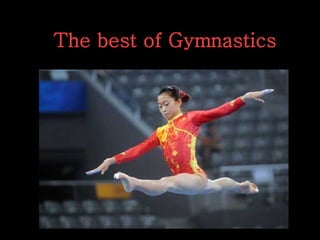
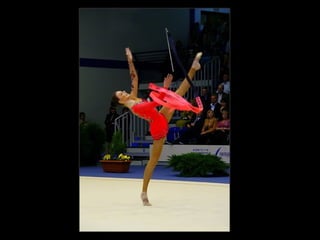
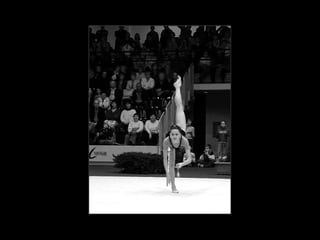
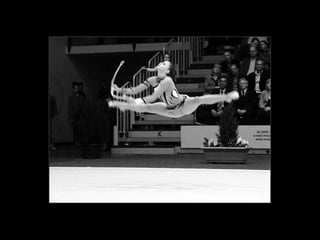
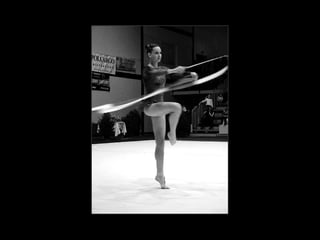
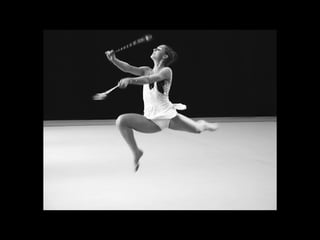
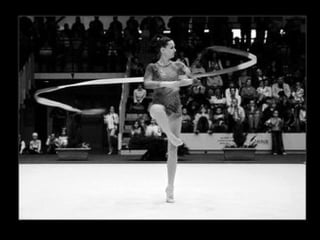
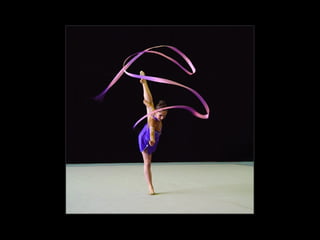
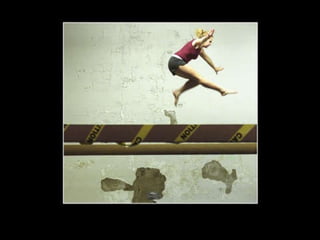

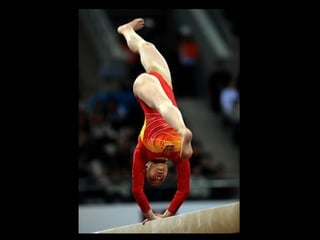

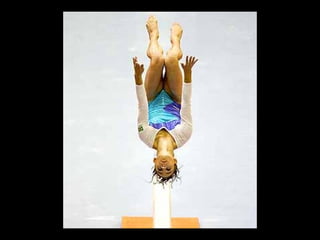



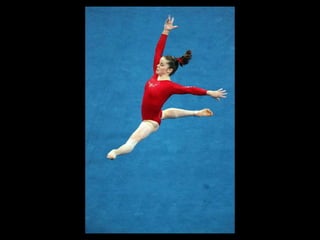
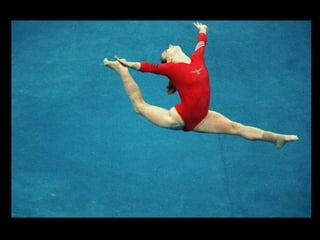

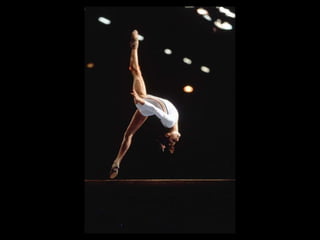
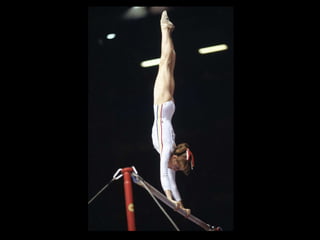
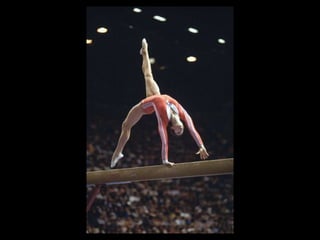
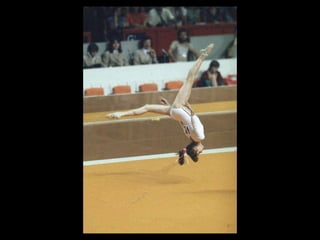


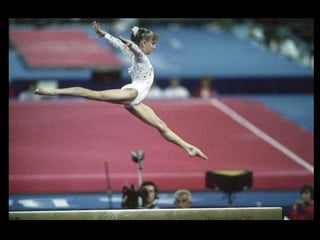
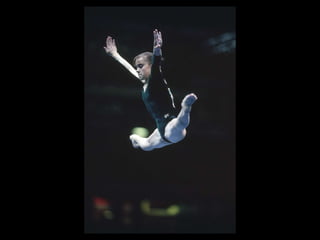


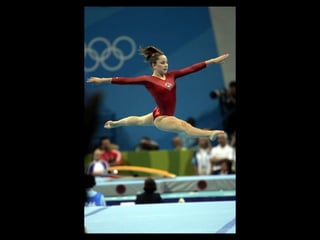
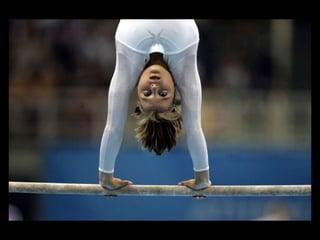

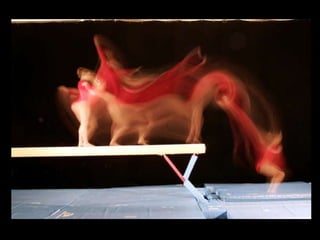
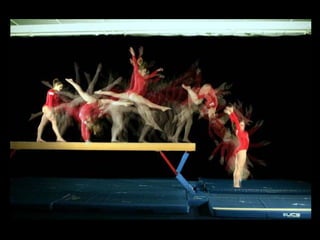
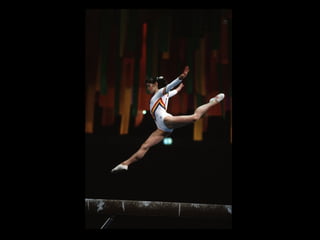


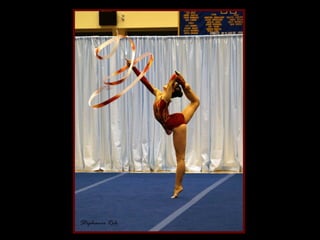

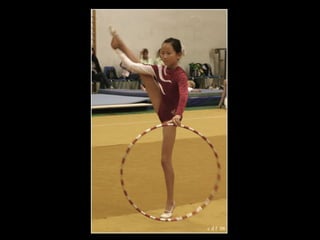
Recommended
Gymnastics
Gymnasticshm alumia
╠²
The document provides a comprehensive overview of gymnastics, detailing its etymology, historical development, and the evolution of competitions and governing bodies. It discusses key gymnastics apparatus, important skills, safety rules, and the significance of costumes and conditioning in the sport. Additionally, it highlights notable events and figures in gymnastics history, including the introduction of women's competitions and advancements in scoring systems.Gymnastics
GymnasticsEmmanuel Alimpolos
╠²
Gymnastics is a competitive sport that tests strength, rhythm, balance, flexibility and agility. There are three major forms: rhythmic gymnastics, artistic gymnastics, and trampoline. Rhythmic gymnastics is only for females while artistic and trampoline are for both males and females. Gymnastics originated from ancient civilizations and has evolved over time with contributions from many individuals around the world, including the development of apparatuses and the introduction of gymnastics into school curriculums and competitions.Gymnast
GymnastJeaza Sandoy
╠²
Gymnastics is a sport that requires flexibility, balance, and control. It involves performing exercises on equipment like the vault, uneven bars, balance beam, floor, pommel horse, rings and parallel bars for men and rhythmic gymnastics apparatuses for women. Gymnastics has evolved from ancient Greek exercises and circus skills and includes competitive gymnastics at all levels as well as recreational and performance gymnastics. The modern sport has standardized apparatus and scoring systems.Gymnastics grade 7 PE
Gymnastics grade 7 PE Tentaw Ban
╠²
There are three main types of gymnastics: women's artistic gymnastics, men's artistic gymnastics, and rhythmic gymnastics. Women's artistic gymnastics has the most participants and is featured in the Olympics, with athletes competing on vault, uneven bars, balance beam, and floor exercise. Men's artistic gymnastics is the second most popular in the US and oldest form, with athletes competing on floor, pommel horse, rings, vault, parallel bars, and high bar. Rhythmic gymnastics involves performances with different apparatus like rope, hoop, ball, clubs, and ribbon.(gymnastics)
(gymnastics)Cristopher Sodusta
╠²
Gymnastics has its origins in early civilizations as a system of exercises, stunts, and skills involving swinging, balancing, climbing and turning. The Germans were major contributors to developing the modern gymnastics program. Gymnastics became an Olympic sport in 1896 for men and 1928 for women. In the Philippines, gymnastics was introduced through conditioning exercises and dancing, later becoming a competitive sport. The first Philippine gymnastics team competed in the 1964 Olympics in Tokyo. The objectives of gymnastics include developing coordination, correcting posture, maintaining health, and learning life-long conditioning exercises.GYMNASTICS (Paula y Mª Helena)
GYMNASTICS (Paula y Mª Helena)temago
╠²
The document outlines 5 types of gymnastics: general gymnastics, artistic gymnastics, rhythmic gymnastics, aerobic gymnastics, acrobatic gymnastics, and trampoline gymnastics. General gymnastics involves groups performing synchronized choreography. Artistic gymnastics involves high-speed body movements and can include male and female gymnasts. Rhythmic gymnastics combines dance, gymnastics, and the use of equipment like balls and ropes performed to music individually or in groups.Gymnastics
Gymnastics KATHRYN RAYMUNDO
╠²
Gymnastics stunts can be individual, dual, or group activities. Individual stunts like the turk stand, rocking chair, and prone rocking test flexibility, balance, and strength. Dual stunts such as the wheelbarrow and knee stand involve two people. Group stunts include pyramids with multiple flyers and bases. Common individual stunts are described in detail, along with dual stunts like the handstand and group stunts including the full elevator and liberties. Stunts build skills and can be used for conditioning exercises or gymnastic introductions.Gymnastics
Gymnasticstlwaddle
╠²
Gymnastics is a sport that was invented in the 1700s by Friedrich Jahn and involves performing stunts, tricks and routines on large equipment like bars, beams, vaults and floors in gymnasiums around the world. To be a gymnast requires being very flexible and gymnastics involves skills performed on bars, beams, vaults and floors using equipment like pits, harnesses and mats for protection.The viisliam 4 in-1 flashlight is a must have
The viisliam 4 in-1 flashlight is a must haveViisLiam
╠²
The Viisliam 4-in-1 Flashlight is a versatile tool that should be included in every emergency kit. It functions as a flashlight, work light, flashing emergency light, and has a powerful magnetic base. The flashlight can illuminate work areas like changing a tire on the side of the road or electrical breaker panels during a power outage. It also functions as an emergency strobe light to alert drivers of a stopped vehicle. The 4-in-1 design provides multiple functions in a single device, making it a useful item to have available in any emergency situation.Karencheer
Karencheerkaren
╠²
The document discusses several basic cheerleading stunts including the cartwheel, round off, back handspring, front and back flips, and various splits. It provides brief descriptions of each stunt and cheers for cheerleading at the end.Tactical Flashlight Tips
Tactical Flashlight TipsViisLiam
╠²
During a tornado in the document author's hometown of Arlington, TX, their power went out and they needed a flashlight to see to get to a safe place. A flashlight can help people see in the dark for various occupations as well, such as a police officer using one attached to their service weapon in a dark shooting situation. The document discusses tips for using a tactical flashlight, such as using quick bursts of light instead of leaving it on continuously, moving between bursts, and not backlighting teammates to avoid being identified. It also notes that illuminating a whole room by aiming the light at the ceiling can help determine threats or hostages.Third term p.e
Third term p.eMar├Ła Moreno Vicioso
╠²
The document describes various gymnastics skills and indoor soccer rules. It explains how to perform a handstand, cartwheel, and forward and backward roll in gymnastics. It also outlines the techniques used in indoor soccer, such as passing and kicking the ball to score goals. The court dimensions for indoor soccer are provided as 20 meters wide and 40 meters long. Fouls and penalty rules for indoor soccer games are summarized as well.Meg grundyyyyyyy
Meg grundyyyyyyyMarquettestudent
╠²
This document provides an overview of gymnastics and what is required to be a gymnast. It discusses the importance of mental and physical strength and dedication. Daily practice includes exercises like handstand pushups, running, and chin-ups. Gymnasts must have flexibility and work with coaches to learn skills while managing fear with spotting. Both girls and boys compete in different events. Top American Olympic gold medalists are named.Lesson3 injuries
Lesson3 injurieswschukraft
╠²
The document discusses various types of injuries including muscle cramps caused by overuse or dehydration, muscle strains from overuse or poor form that cause swelling and pain, and sprains from overextending joints that can range from mild to severe ligament tears. It also covers treatments like RICE (rest, ice, compression, and elevation) for minor injuries and immobilization methods like casts, clamps, and screws for fractures. More serious injuries mentioned include dislocations, tendonitis, concussions from blows to the head, and heat-related risks such as heat cramps, heat exhaustion, and heatstroke. Protective equipment is also recommended.Rythmic gymnastics
Rythmic gymnasticsLidiaGon
╠²
Rhythmic gymnastics is an individual sport that involves manipulating apparatuses like clubs, hoops, balls, ribbons, and ropes while incorporating elements of ballet, gymnastics, and dance. It originated in Russia in the 1950s and became an official Olympic sport in 1984. Competitions are judged on skills with the apparatuses and the choreography covering the floor to music. Top rhythmic gymnasts need balance, flexibility, coordination and strength to earn points from judges for their performance and apparatus handling.Sharvan kumar mandal
Sharvan kumar mandalPawan Kumar
╠²
Kho-Kho is a traditional game that promotes physical development and motor skills through vigorous play, involving two teams of 12 players each with 9 on the field. The game consists of two 9-minute innings (or 7 minutes for sub-juniors) with various skills like sprinting and dodging, and is played on a rectangular field with specific measurements depending on age categories. It is officiated by a team of six officials and can be played on different surfaces, including turf and synthetic grounds.My PowerPoint of triple jump
My PowerPoint of triple jumpPaqui101
╠²
The document discusses the triple jump event in track and field. It describes the goal of achieving the greatest distance over three jumps, either left-left-right or right-right-left. The event was introduced in the 1896 Olympics and the current men's world record is 18.29 meters by Jonathan Edwards and the women's record is 15.50 meters by Inessa Kravets. Installation is similar to long jump but with the take-off board located 13 meters for international competitions.Gymnastics Conditioning by Karen Goeller, CSCS
Gymnastics Conditioning by Karen Goeller, CSCSSwing Set Fitness
╠²
The document emphasizes the importance of gymnastics-specific conditioning for athletes, particularly addressing the difference between general strength exercises and movements required for skills like the cast handstand. It discusses the need for tailored drills that reflect the movements in gymnastics to ensure proper muscle development and prevent injuries. Additionally, the document highlights the role of the psoas muscle in performing jumps and leaps, advocating for a comprehensive training program that includes strength, conditioning, flexibility, and injury prevention.Volleyball Scoring
Volleyball Scoringeharriscoach
╠²
The document details a rally scoring sample game between team A and team B in a varsity match held on October 13, 2002, at Hinkle Field House, with team A as the home team. It outlines the game flow, including serves, substitutions, points scored, and penalties, culminating in team A winning the game point at 8:02 PM. The referee was Bob Smith, and the umpire was Julie Collins.Flashlight friday rules
Flashlight friday rulesJessica Drinks
╠²
The document provides rules for using a flashlight for reading fun, instructing the reader to gather 3-4 books and magazines, find a spot to sit and stay there while shining the light only on the book, and if finished to re-read instead of wandering or searching, then to turn off the flashlight and return it at the end.Indian Traditional Games Festival, Singapore 2010
Indian Traditional Games Festival, Singapore 2010Vivek Sathe
╠²
The Indian Traditional Games Festival, organized by Vivekanand Seva Sangh (Singapore), took place on April 18, 2010, celebrating Hindu New Year with various traditional games such as kabaddi, kho-kho, and lagori. The event included numerous matches attracting over 300 participants across different age groups, emphasizing moral values, social service, and community coordination. Winners were announced for various contests, highlighting achievements in sports and cultural demonstrations throughout the day.Gymnastic floor skills
Gymnastic floor skillsCarmelo Gil Guti├®rrez
╠²
The document provides instructions for performing several gymnastics floor skills:
1) The forward somersault involves rolling through the body in a straight line while keeping the back rounded and feet together, and landing on one's feet.
2) The backward somersault is similar but starts from a crouched position and uses the hands to push off the floor and avoid pressure on the neck.
3) The headstand balances the body vertically on the forehead and hands in a triangular position with the legs lifted overhead.
4) The handstand maintains an inverted vertical position supported by straight arms while lifting one leg at a time to join overhead.Olympic Sports
Olympic SportsDavid Deubelbeiss
╠²
The document lists various sports that are part of the Summer Olympics including beach volleyball, indoor volleyball, diving, water polo, triathlon, swimming, synchronized swimming, baseball, softball, weightlifting, taekwondo, archery, gymnastics, rhythmic gymnastics, trampoline, judo, badminton, boxing, field hockey, wrestling, shooting, rowing, sailing, kayaking, basketball, tennis, table tennis, windsurfing, athletics (track and field), cycling, mountain biking, BMX, fencing, and handball. It also includes the Olympic motto "Citius, Altius, Fortius" which means "SwifterAssociation football
Association footballjuanmeta500
╠²
Football, commonly known as soccer, is played between two teams of 11 players using a spherical ball on a rectangular field. The history of football can be traced back to medieval England, though the sport is now played professionally worldwide under a standardized set of rules. The objective is to score more goals than the opposing team by kicking the ball into their goal. Major international competitions include the World Cup held every four years featuring national teams from around the world, and continental championships organized within each confederation.Fuwa Fever
Fuwa FeverCat C
╠²
Fuwa are the five mascot characters representing the Beijing 2008 Olympic Games. They are designed based on five children and embody four popular Chinese animals - the Fish, Panda, Tibetan Antelope, Swallow - and the Olympic Flame. Each mascot symbolizes Chinese cultural elements and traditions and carries blessings of prosperity, happiness, passion, health and luck. They also represent the five Olympic rings through their association with different sports.More Related Content
Viewers also liked (17)
The viisliam 4 in-1 flashlight is a must have
The viisliam 4 in-1 flashlight is a must haveViisLiam
╠²
The Viisliam 4-in-1 Flashlight is a versatile tool that should be included in every emergency kit. It functions as a flashlight, work light, flashing emergency light, and has a powerful magnetic base. The flashlight can illuminate work areas like changing a tire on the side of the road or electrical breaker panels during a power outage. It also functions as an emergency strobe light to alert drivers of a stopped vehicle. The 4-in-1 design provides multiple functions in a single device, making it a useful item to have available in any emergency situation.Karencheer
Karencheerkaren
╠²
The document discusses several basic cheerleading stunts including the cartwheel, round off, back handspring, front and back flips, and various splits. It provides brief descriptions of each stunt and cheers for cheerleading at the end.Tactical Flashlight Tips
Tactical Flashlight TipsViisLiam
╠²
During a tornado in the document author's hometown of Arlington, TX, their power went out and they needed a flashlight to see to get to a safe place. A flashlight can help people see in the dark for various occupations as well, such as a police officer using one attached to their service weapon in a dark shooting situation. The document discusses tips for using a tactical flashlight, such as using quick bursts of light instead of leaving it on continuously, moving between bursts, and not backlighting teammates to avoid being identified. It also notes that illuminating a whole room by aiming the light at the ceiling can help determine threats or hostages.Third term p.e
Third term p.eMar├Ła Moreno Vicioso
╠²
The document describes various gymnastics skills and indoor soccer rules. It explains how to perform a handstand, cartwheel, and forward and backward roll in gymnastics. It also outlines the techniques used in indoor soccer, such as passing and kicking the ball to score goals. The court dimensions for indoor soccer are provided as 20 meters wide and 40 meters long. Fouls and penalty rules for indoor soccer games are summarized as well.Meg grundyyyyyyy
Meg grundyyyyyyyMarquettestudent
╠²
This document provides an overview of gymnastics and what is required to be a gymnast. It discusses the importance of mental and physical strength and dedication. Daily practice includes exercises like handstand pushups, running, and chin-ups. Gymnasts must have flexibility and work with coaches to learn skills while managing fear with spotting. Both girls and boys compete in different events. Top American Olympic gold medalists are named.Lesson3 injuries
Lesson3 injurieswschukraft
╠²
The document discusses various types of injuries including muscle cramps caused by overuse or dehydration, muscle strains from overuse or poor form that cause swelling and pain, and sprains from overextending joints that can range from mild to severe ligament tears. It also covers treatments like RICE (rest, ice, compression, and elevation) for minor injuries and immobilization methods like casts, clamps, and screws for fractures. More serious injuries mentioned include dislocations, tendonitis, concussions from blows to the head, and heat-related risks such as heat cramps, heat exhaustion, and heatstroke. Protective equipment is also recommended.Rythmic gymnastics
Rythmic gymnasticsLidiaGon
╠²
Rhythmic gymnastics is an individual sport that involves manipulating apparatuses like clubs, hoops, balls, ribbons, and ropes while incorporating elements of ballet, gymnastics, and dance. It originated in Russia in the 1950s and became an official Olympic sport in 1984. Competitions are judged on skills with the apparatuses and the choreography covering the floor to music. Top rhythmic gymnasts need balance, flexibility, coordination and strength to earn points from judges for their performance and apparatus handling.Sharvan kumar mandal
Sharvan kumar mandalPawan Kumar
╠²
Kho-Kho is a traditional game that promotes physical development and motor skills through vigorous play, involving two teams of 12 players each with 9 on the field. The game consists of two 9-minute innings (or 7 minutes for sub-juniors) with various skills like sprinting and dodging, and is played on a rectangular field with specific measurements depending on age categories. It is officiated by a team of six officials and can be played on different surfaces, including turf and synthetic grounds.My PowerPoint of triple jump
My PowerPoint of triple jumpPaqui101
╠²
The document discusses the triple jump event in track and field. It describes the goal of achieving the greatest distance over three jumps, either left-left-right or right-right-left. The event was introduced in the 1896 Olympics and the current men's world record is 18.29 meters by Jonathan Edwards and the women's record is 15.50 meters by Inessa Kravets. Installation is similar to long jump but with the take-off board located 13 meters for international competitions.Gymnastics Conditioning by Karen Goeller, CSCS
Gymnastics Conditioning by Karen Goeller, CSCSSwing Set Fitness
╠²
The document emphasizes the importance of gymnastics-specific conditioning for athletes, particularly addressing the difference between general strength exercises and movements required for skills like the cast handstand. It discusses the need for tailored drills that reflect the movements in gymnastics to ensure proper muscle development and prevent injuries. Additionally, the document highlights the role of the psoas muscle in performing jumps and leaps, advocating for a comprehensive training program that includes strength, conditioning, flexibility, and injury prevention.Volleyball Scoring
Volleyball Scoringeharriscoach
╠²
The document details a rally scoring sample game between team A and team B in a varsity match held on October 13, 2002, at Hinkle Field House, with team A as the home team. It outlines the game flow, including serves, substitutions, points scored, and penalties, culminating in team A winning the game point at 8:02 PM. The referee was Bob Smith, and the umpire was Julie Collins.Flashlight friday rules
Flashlight friday rulesJessica Drinks
╠²
The document provides rules for using a flashlight for reading fun, instructing the reader to gather 3-4 books and magazines, find a spot to sit and stay there while shining the light only on the book, and if finished to re-read instead of wandering or searching, then to turn off the flashlight and return it at the end.Indian Traditional Games Festival, Singapore 2010
Indian Traditional Games Festival, Singapore 2010Vivek Sathe
╠²
The Indian Traditional Games Festival, organized by Vivekanand Seva Sangh (Singapore), took place on April 18, 2010, celebrating Hindu New Year with various traditional games such as kabaddi, kho-kho, and lagori. The event included numerous matches attracting over 300 participants across different age groups, emphasizing moral values, social service, and community coordination. Winners were announced for various contests, highlighting achievements in sports and cultural demonstrations throughout the day.Gymnastic floor skills
Gymnastic floor skillsCarmelo Gil Guti├®rrez
╠²
The document provides instructions for performing several gymnastics floor skills:
1) The forward somersault involves rolling through the body in a straight line while keeping the back rounded and feet together, and landing on one's feet.
2) The backward somersault is similar but starts from a crouched position and uses the hands to push off the floor and avoid pressure on the neck.
3) The headstand balances the body vertically on the forehead and hands in a triangular position with the legs lifted overhead.
4) The handstand maintains an inverted vertical position supported by straight arms while lifting one leg at a time to join overhead.Olympic Sports
Olympic SportsDavid Deubelbeiss
╠²
The document lists various sports that are part of the Summer Olympics including beach volleyball, indoor volleyball, diving, water polo, triathlon, swimming, synchronized swimming, baseball, softball, weightlifting, taekwondo, archery, gymnastics, rhythmic gymnastics, trampoline, judo, badminton, boxing, field hockey, wrestling, shooting, rowing, sailing, kayaking, basketball, tennis, table tennis, windsurfing, athletics (track and field), cycling, mountain biking, BMX, fencing, and handball. It also includes the Olympic motto "Citius, Altius, Fortius" which means "SwifterAssociation football
Association footballjuanmeta500
╠²
Football, commonly known as soccer, is played between two teams of 11 players using a spherical ball on a rectangular field. The history of football can be traced back to medieval England, though the sport is now played professionally worldwide under a standardized set of rules. The objective is to score more goals than the opposing team by kicking the ball into their goal. Major international competitions include the World Cup held every four years featuring national teams from around the world, and continental championships organized within each confederation.More from Cat C (20)
Fuwa Fever
Fuwa FeverCat C
╠²
Fuwa are the five mascot characters representing the Beijing 2008 Olympic Games. They are designed based on five children and embody four popular Chinese animals - the Fish, Panda, Tibetan Antelope, Swallow - and the Olympic Flame. Each mascot symbolizes Chinese cultural elements and traditions and carries blessings of prosperity, happiness, passion, health and luck. They also represent the five Olympic rings through their association with different sports.AromaterapiaCat C
╠²
La aromaterapia es una terapia hol├Łstica que utiliza aceites esenciales extra├Łdos de plantas para tratar desequilibrios psicof├Łsicos. Tiene sus ra├Łces en pr├Īcticas curativas antiguas como el uso de humos de plantas por parte de pueblos primitivos y fue desarrollada por civilizaciones como los egipcios, griegos y romanos. En la actualidad, la aromaterapia se basa en el empleo de aceites esenciales puros y naturales para curar y preservar la salChild In Our Eyes
Child In Our EyesCat C
╠²
This document contains quotes and observations about children. It notes that children represent the future and can ask questions adults cannot answer. Children live in the present moment and see wonders in the world that adults overlook. While unpredictable, children deserve love especially when misbehaving. Their youthful minds allow novel ways of thinking unconstrained by what was learned before.Dancing quotes
Dancing quotesCat C
╠²
Dancing quotes from various authors express that dancing allows one to transcend themselves and connect both body and soul. It is seen as a form of communication when words cannot suffice and provides health benefits. Dancing is described as an expression of life, emotion, and rhythm that can be done anywhere, including in one's heart.Dance LentoCat C
╠²
Este poema enfatiza la importancia de vivir la vida con calma y apreciar los peque├▒os momentos en lugar de apresurarse constantemente. Hace referencia a observar ni├▒os en un carrusel, escuchar la lluvia, seguir mariposas y ver el atardecer como ejemplos de actividades simples que se pierden cuando se vive demasiado r├Īpido. Recomienda desacelerar el ritmo para no perderse la satisfacci├│n de llegar a destino ni dejar morir amistades por falta de tiempo.Sindrome De DownCat C
╠²
El documento proporciona informaci├│n sobre el s├Łndrome de Down, incluyendo su causa gen├®tica, su prevalencia, las caracter├Łsticas f├Łsicas asociadas y las posibilidades de desarrollo e integraci├│n de las personas que lo padecen. Se explica que a trav├®s de programas educativos adecuados aplicados desde una edad temprana, las personas con s├Łndrome de Down pueden alcanzar su m├Īximo potencial y llevar una vida independiente e integrada en la sociedad.Mitolog├ŁA N├│RdicaCat C
╠²
El documento resume la mitolog├Ła n├│rdica, incluyendo su origen, cosmolog├Ła y fuentes principales como las Eddas. Describe que los dioses Od├Łn, Vili y V├® mataron a Ymir y crearon el mundo a partir de su cuerpo, y que los primeros humanos fueron Ask y Embla. Explica que los nueve mundos est├Īn conectados por el ├Īrbol Yggdrasil.Recently uploaded (14)
Nowgoal Prediction Manchester City vs Wydad Casablanca 6.18.docx
Nowgoal Prediction Manchester City vs Wydad Casablanca 6.18.docxnowgoalar7
╠²
Nowgoal Prediction: Manchester City vs. Wydad CasablancaDavid Bennett Galloway III_ Exploring the Three Main Types of Volunteering .pdf
David Bennett Galloway III_ Exploring the Three Main Types of Volunteering .pdfDavid Bennett Galloway III
╠²
Informal volunteering, on the other hand, is more flexible and typically involves helping individuals or small groups directly without the structure of a formal organization. This could include helping a neighbor with groceries, tutoring a child, or assisting with community clean-ups. Informal volunteering doesnŌĆÖt require an application or extensive training, making it an excellent option for those who want to give back in a more spontaneous or personal way. This type of volunteering allows for more freedom and a closer connection to those youŌĆÖre helping.
Black Sabbath 2025 Tool Reunites for Sabbath Farewell.docx
Black Sabbath 2025 Tool Reunites for Sabbath Farewell.docxEticketing General
╠²
DonŌĆÖt miss your chance to be part of rock history with Black Sabbath Back to the Beginning Tickets, available now on eticketing.co! Witness the iconic reunion of Black SabbathŌĆÖs original lineup of Ozzy Osbourne, Tony Iommi, Geezer Butler, and Bill Ward for their final performance. Secure your tickets today for a once-in-a-lifetime experience!LEARNING THE RULES OF MUAY THAI - ALEXANDRE BRECK.pdf
LEARNING THE RULES OF MUAY THAI - ALEXANDRE BRECK.pdfALEXANDRE BRECK
╠²
LEARNING THE RULES OF MUAY THAI - ALEXANDRE BRECKBritish and Irish Lions Fall to Argentina in 2025 Tour Open.docx
British and Irish Lions Fall to Argentina in 2025 Tour Open.docxeticketing
╠²
At eticketing.co, fans can find a secure and trusted platform to book official British and Irish Lions Tickets. With options to suit every budget from standard seats to premium hospitality packages. Whether youŌĆÖre planning to attend a single match or follow the tour across Brisbane, Melbourne, and Sydney, we make your ticket-buying experience simple, safe, and seamless.
Sprint Training ║▌║▌▀Ż Deck from Andrew Sheaff
Sprint Training ║▌║▌▀Ż Deck from Andrew SheaffMark Rauterkus
╠²
Andrew Sheaff presents about swimming sprint training to the audience at WAFSU.org, the World Aquatic Federation of Schools and Universities. See WAFSU.org. This is part of the lesson in the course on Bygone Seminars.The History of Panini From Sticker Albums to Global Card Giant
The History of Panini From Sticker Albums to Global Card GiantAshley Jones
╠²
Panini Cards began in 1961 with a simple football sticker album in Italy. Evolving from a local craze to a global phenomenon, Panini revolutionized collectible culture. Known for sports cards and licensed memorabilia, Panini Cards now dominate international markets, partnering with major leagues like FIFA and the NBA. Their iconic albums remain a nostalgic favorite and a collectorŌĆÖs essential worldwide. To know more visit here https://thecardvault.co.uk/collections/sports-trading-cards-panini-toppsBritish and Irish Lions FarrellŌĆÖs Leadership Born in Crisis.docx
British and Irish Lions FarrellŌĆÖs Leadership Born in Crisis.docxeticketing
╠²
At eticketing.co, fans can find a secure and trusted platform to book official British and Irish Lions Tickets. With options to suit every budget from standard seats to premium hospitality packages. Whether youŌĆÖre planning to attend a single match or follow the tour across Brisbane, Melbourne, and Sydney, we make your ticket-buying experience simple, safe, and seamless.
The Essence of Competition ŌĆō Sportsmanship & Fair Play with TIDA Sports
The Essence of Competition ŌĆō Sportsmanship & Fair Play with TIDA SportsTIDA Sports
╠²
¤Åģ True competition isnŌĆÖt just about winning ŌĆö itŌĆÖs about how you play the game.
At TIDA Sports, we teach athletes that greatness lies in respect, integrity, and discipline. ¤Æ»
From the field to the court, we celebrate those who lift others up, follow the rules, and play with heart ŌĆö because sportsmanship is the real victory. ¤½▒¤ÅĮŌĆŹ¤½▓¤ÅĮ
ŌÜĪ Be fierce, be fair, be unforgettable.
¤Ä» Train with TIDA. Compete with character.
#TIDASports #FairPlayFirst #SpiritOfTheGame #SportsmanshipMatters #CompeteWithCharacter #YouthDevelopment #RespectInSports #TrainWithTIDA #NextGenChampions #TrueAthleteSpirit #RiseWithTIDACycling and Technology - How Tech is Changing the Way We Ride
Cycling and Technology - How Tech is Changing the Way We RideNiall O'Riordan UBS
╠²
As an avid cyclist who's spent countless hours on both mountain trails and winding roads, I've witnessed firsthand how technology has transformed our beloved sport. Today, let's explore the exciting ways tech is enhancing our cycling experiences.
Global Esport Market Analysis - 2025-2034
Global Esport Market Analysis - 2025-2034Market.us
╠²
The global esports market is projected to grow significantly, reaching USD 16.7 Billion by 2033, up from USD 2.3 Billion in 2023, driven by a strong CAGR of 21.9% over the forecast period. In 2023, the live-streaming segment dominated the market with a substantial 63.1% share, reflecting the increasing popularity of real-time game broadcasts and fan engagement platforms.
Rea More - https://market.us/report/esports-market/
Additionally, the media rights segment held a significant 27% share, fueled by the rising demand for exclusive broadcasting deals and sponsorship revenues. Regionally, North America led the market, capturing over 36.3% share, amounting to USD 0.83 Billion, supported by strong infrastructure, active gamer communities, and major investments in esports tournaments and content creation.Micro Marking System by Diwakar Sir Gurukul Haridwar.pptx
Micro Marking System by Diwakar Sir Gurukul Haridwar.pptxDiwakar Kashyap
╠²
Delivered two different lectures during the 5th Yogasana State Judge Training Program of Uttar Pradesh ¤¦śŌĆŹŌÖĆ’ĖŤ¦śŌĆŹŌÖé’ĖÅ
Topic - Micro Marking Guidelines and Forward & Backbend Individual Event
#PEFI #UPYSA
#YogasanaBharat
#diwakaryogasanabharat
#diwakarupysa #diwakarpefi
#diwakarkashyapphysicaleducation
#diwakarphysicaleducation
#diwakarsportswallah
#dksportswallah
#diwakarsports
#diwakaryoga
#sportswallah
#sportsvala
#dksportsDavid Bennett Galloway III_ Exploring the Three Main Types of Volunteering .pdf
David Bennett Galloway III_ Exploring the Three Main Types of Volunteering .pdfDavid Bennett Galloway III
╠²
